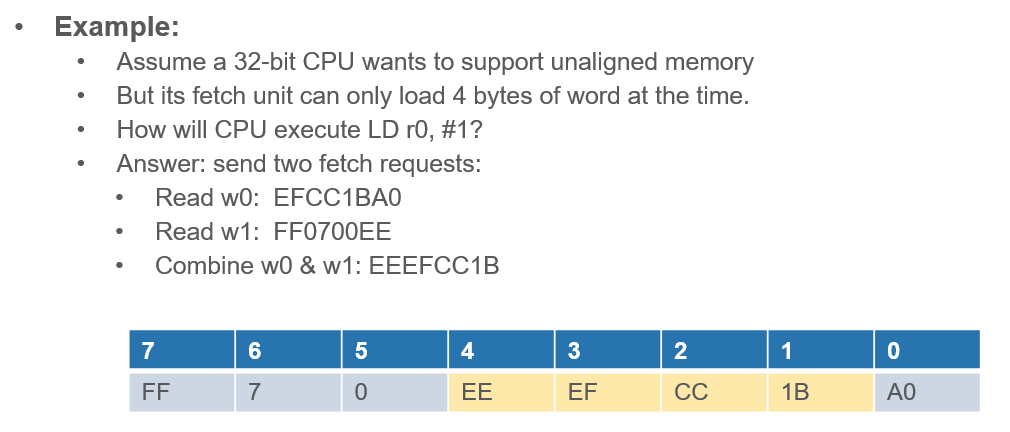3 - Addressing
ucla | CS M151B | 2024-01-16 16:11
Table of Contents
Addressing/Indexing
Register File
- fairly small, array of ids mapped to addresses of data
- made of fast SRAM tech
Main Memory File
- made of slower DRAM tech
- array of ids mapped to addresses
- connected via system bus
Address Space
- the system address bus can connect any peripherals including DRAM memory sticks
- so the same address space shares addresses for peripherals AND memory addresses
- the PU only observes address names/ids it doesn’t recognize whether this belongs to the peripheral address space or not -> this is burdened on the programmer
ISA
- memory alignment, available instructions, opcodes, addressing modes, endianness (big endian little endian)
Addressing Modes
- immediate addressing
- operand is directly embedding values, e.g.,
add r0 #5 - here
#5is a direct value - fast to decode but cannot change operand at runtime and range limited
- operand is directly embedding values, e.g.,
- register addressing
- operands are registers:
add r0 r1 - limited by register file size:
r0,r1,rdx,... - fast to decode and fast access from registers bc of SRAM tech
- register dependency tracking cost -> deciding order
- operands are registers:
- direct addressing
- operand is a memory address which can be accessed
- e.g.,
LD r0 0xFF - fast to decode and large available range
- memory latency due to DRAM
- cannot easily change +/- the address on the fly
- indirect addressing
- operand accessing the value stored in the register
- e.g.,
add r0 (r1)here the CPU gets the value atr0and adds it to the value pointed to by the address in the storage of ther1 - flexible dynamic addresses and range
- but slower access and complex execution
- this is kind of syntactic sugar by combining 2 operations: load and add
- displacement addressing
-
add r0 #5(r1)i.e. the value atr1+ 5 is now the address loaded to the ALU - flexibility as above and fewer instructions
- but limited offset range and computation overhead
- e.g. when using struct based: ``` struct Student: int uid; int age;
a = new Student(305000999,19); a.age; -> @ a+4 bytes (32-bit machine) ```
-
- indexed addressiing
add r0 r1(r2)- dynamic offset of dynamic addressing
- e.g. dynamic accessing in a for loop
students = new Student for _ in range(10) for i in range(10): students[i].age; -> @ r1+r2 (where r1 is 0 offset and r2 is i*8 bytes + 4 bytes)
- relative addressing
- mostly branch instructions where operand is a memory address relative to PC
-
JMP +4jumps to memory at PC+4 - flexible branching but limited range due to instruction size limit
- stack addressing
- assuming memory on the stack
-
push r0orpop r0 - pushes value of r0 to top of stack and pop takes value at top into r0
- the hardware is responsible for incrementing addresses
- limited call stack and branching but easy memory management
Encoding large immediate/direct addressing
- variable length instructions and use multiple instructions
- dynamic address calculation
- e.g.
mov r2 (r1)0xFFA0-> -
mov r3 A0andmov r4 FF shiftL r4 (r4)0x8-
add r4 r3Memory Alignment
- memory is a contiguous array so constrain access to some multiple
- e.g. in a 32 bit machine, generally the size of the data or 4 byte alignment
- big endian - the big end of a data e.g., in 0xFFA0, FF is the big end is stored in the smallesst bytes of memory e.g. in 0x00AA, FF is stored in 0xAA and FF in 0x00
- little endian is the opposite - allows the ALU to read as is, most machines use this
Control status registers
- special storage flags
- e.g. divide by zero flag, FPU config flags (rounding mode), FPU status flags (overflow)
